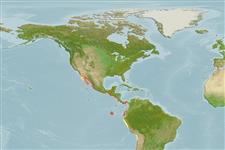>
Eupercaria/misc (Various families in series Eupercaria) >
Labridae (Wrasses) > Bodianinae
Etymology: Bodianus: Bodianus after Bodiano or Pudiano, from the Portuguese pudor, meaning modesty (Jordan & Evermann, 1896).; diplotaenia: Name from the Greek diploos, meaning 'twofold', and feminine noun tainia for ribbon, referring to the two prominent dark stripes on the body of juveniles and initial phase adults (Ref. 75973).
More on author: Gill.
Environment: milieu / climate zone / depth range / distribution range
นิเวศวิทยา
เกี่ยวกับทะเล,น้ำเค็ม เกี่ยวกับหินโสโครก; ระดับความลึก 5 - 76 m (Ref. 9311), usually 5 - 18 m (Ref. 9311). Subtropical; 32°N -
Eastern Pacific: Guadalupe Island and throughout the Gulf of California to Chile, including the Cocos, Malpelo, Revillagigedo and the Galapagos islands.
ขนาด / น้ำหนัก / Age
Maturity: Lm ? range ? - ? cm
Max length : 76.0 cm TL เพศผู้/กระเทย; (Ref. 5592); common length : 45.0 cm TL เพศผู้/กระเทย; (Ref. 55763); น้ำหนักสูงสุดที่มีการรายงาน: 9.0 kg (Ref. 5592)
Body moderately deep and compressed; head large and pointed; teeth caniniform, enlarged, and somewhat crooked, two anterior pairs in each jaw; dorsal fin with 12 spines; posterior rays of anal and dorsal fins forming filamentous lobes; lower branch of first gill arch with 12 to 13 gill rakers; very large individuals blue, with a narrow, yellow, vertical bar immediately behind the posterior edge of the pectoral fin, juveniles red or reddish brown; females with 2 longitudinal black stripes (Ref. 55763).
Adults inhabit rocky or coral areas (Ref. 9311). Sometimes also found on sandy bottoms and where marine plants abound (Ref. 9311). Solitary or forms aggregations of only a few individuals. Feed on crabs, brittle stars, mollusks, and sea urchins (Ref. 9311). At night, they agglomerate in cracks and crevices of rocks and caves to sleep (Ref. 9311). Marketed fresh (Ref. 9311). Starts life as a female, later becoming a functional male. Males defend temporary reproductive territories called leks. Sex change may be due to local social conditions, but it may also have a genetic component, since the reversal occurs over a limited size range (Ref. 28023). Oviparous, distinct pairing during breeding (Ref. 205).
Life cycle and mating behavior
วัยเจริญพันธุ์ | การสืบพันธุ์ | การวางไข่ | เซลสืบพันธ์ของเพศเมีย(ไข่) | ความดกของไข่ | ตัวอ่อน
Oviparous, distinct pairing during breeding (Ref. 205).
Thomson, D.A., 1987. Reef fishes of the Sea of Cortez. The rocky-shore fishes of the Gulf of California. The University of Arizona Press, Tucson. 302 p. (Ref. 5592)
IUCN Red List Status (Ref. 130435)
Threat to humans
Harmless
Human uses
สถานที่แสดงสัตว์และพืชน้ำ: การค้า
ข้อมูลเพิ่มเติม
ชื่อสามัญชื่อพ้องกลไกการเผาผลาญพลังงานผู้ล่าการศึกษาเกี่ยวกับผลกระทบของสารประกอบทางเคมีที่เป็นอันตรายต่อสิ่งมีชีวิต ประชากร และสิ่งแวดล้อมการสืบพันธุ์วัยเจริญพันธุ์การวางไข่การรวมกลุ่มวางไข่ความดกของไข่เซลสืบพันธ์ของเพศเมีย(ไข่)Egg development
อ้างอิงการเพาะเลี้ยงสัตว์น้ำประวัติการเพาะเลี้ยงสัตว์น้ำสายพันธุ์พันธุศาสตร์ElectrophoresesอัตราพันธุกรรมโรคการแปรรูปNutrientsMass conversion
ผู้ร่วมมือรูปภาพหลายรูปStamps, Coins Misc.เสียงปลามีพิษ เช่น ปลาปักเป้าความเร็วรูปแบบการว่ายน้ำพื้นที่เหงือกOtolithsสมองวิสัยทัศน์
เครื่องมือ
Special reports
Download XML
แหล่งที่มาจากอินเตอร์เน็ต
Estimates based on models
Preferred temperature (Ref.
123201): 20.6 - 28.9, mean 26.2 °C (based on 286 cells).
Phylogenetic diversity index (Ref.
82804): PD
50 = 0.5000 [Uniqueness, from 0.5 = low to 2.0 = high].
Bayesian length-weight: a=0.01202 (0.00551 - 0.02625), b=3.05 (2.87 - 3.23), in cm total length, based on LWR estimates for this Genus-body shape (Ref.
93245).
ระดับชั้นอาหาร (Ref.
69278): 3.4 ±0.46 se; based on food items.
ความสามารถในการกลับคืนสู่ปกติ (Ref.
120179): ต่ำมาก, เวลาต่ำสุดที่จะทำให้ประชากรเพิ่มขึ้นเป็น 2 เท่าใช้เวลามากกว่า 14 ปี (Preliminary K or Fecundity.).
Fishing Vulnerability (Ref.
59153): Moderate to high vulnerability (50 of 100).
Nutrients (Ref.
124155): Calcium = 18.5 [9.0, 35.3] mg/100g; Iron = 0.479 [0.265, 0.904] mg/100g; Protein = 19.3 [16.4, 21.5] %; Omega3 = 0.189 [0.109, 0.326] g/100g; Selenium = 19.3 [9.6, 36.8] μg/100g; VitaminA = 44.1 [13.7, 174.4] μg/100g; Zinc = 0.775 [0.531, 1.280] mg/100g (wet weight);
